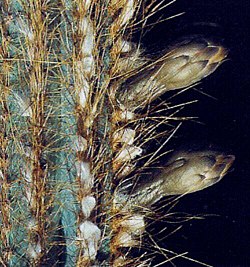| Image | Scientific name | Distribution |
|---|
 | Pilosocereus albisummus P.J.Braun & Esteves | Minas Gerais, Brazil |
 | Pilosocereus alensis (F.A.C.Weber ex Rol.-Goss.) Byles & G.D.Rowley | Western Mexico |
 | Pilosocereus armatus (Otto ex Pfeiff.) A.R.Franck | Puerto Rico and the Virgin Islands |
 | Pilosocereus arrabidae (Steud.) Byles & G.D.Rowley | Brazil |
 | Pilosocereus aureispinus (Buining & Brederoo) F.Ritter | Brazil |
 | Pilosocereus aurisetus (Werderm.) Byles & G.D.Rowley | Minas Gerais, Brazil |
| Pilosocereus azulensis N.P.Taylor & Zappi | Minas Gerais, Brazil |
 | Pilosocereus brasiliensis (Britton & Rose) Backeb. | East Brazil |
 | Pilosocereus brauniorum (Esteves) N.P.Taylor & Zappi | Minas Gerais, Brazil |
| Pilosocereus brevispinus Hoxey & Gdaniec | Central Hispaniola |
| Pilosocereus brooksianus (Britton & Rose) Byles & G.D.Rowley | Southeast Cuba |
| Pilosocereus catalani (Riccob.) Byles & G.D.Rowley | Unknown, possibly Brazil |
| Pilosocereus catimbauensis (N.P.Taylor & Albuq.-Lima) N.P.Taylor & Albuq.-Lima | Pernambuco, Brazil |
 | Pilosocereus catingicola (Gürke) Byles & G.D.Rowley | Rio Grande do Norte, Pernambuco, Alagoas, Sergipe, Paraíba, Bahia. |
 | Pilosocereus chrysacanthus (F.A.C.Weber ex K.Schum.) Byles & G.D.Rowley | Mexico and Honduras |
 | Pilosocereus chrysostele (Vaupel) Byles & G.D.Rowley | Brazil |
 | Pilosocereus collinsii (Britton & Rose) Byles & G.D.Rowley | Oaxaca, Mexico |
 | Pilosocereus colombianus (Rose) Byles & G.D.Rowley | Colombia, Ecuador |
 | Pilosocereus curtisii (Otto) A.R.Franck | The Lesser Antilles and the British Virgin Islands |
 | Pilosocereus densiareolatus F.Ritter | East Brazil |
 | Pilosocereus diersianus (Esteves) P.J.Braun | Tocantins and Goiás |
| Pilosocereus excelsus Hoxey & Gdaniec | East Dominican Republic |
| Pilosocereus flavipulvinatus (Buining & Brederoo) F.Ritter | Northern Brazil |
 | Pilosocereus flexibilispinus P.J.Braun & Esteves | Central Brazil |
 | Pilosocereus floccosus Byles & G.D.Rowley | East Brazil |
 | Pilosocereus fulvilanatus (Buining & Brederoo) F.Ritter | Minas Gerais, Brazil |
 | Pilosocereus gaumeri (Britton & Rose) Backeb. | Southeast Mexico |
 | Pilosocereus glaucochrous (Werderm.) Byles & G.D.Rowley | Northeast Brazil |
| Pilosocereus jamaicensis Proctor | Cayman Islands, Jamaica |
| Pilosocereus juaruensis (Buining & Brederoo) P.J.Braun | Central Brazil, Northeast Paraguay |
 | Pilosocereus kanukuensis (Alexander) Leuenb. | Kanuku mountains, Guyana |
 | Pilosocereus lanuginosus (L.) Byles & G.D.Rowley | Netherlands Antilles |
 | Pilosocereus leucocephalus (Poselg.) Byles & G.D.Rowley | Mexico, Honduras |
 | Pilosocereus machrisii (E.Y.Dawson) Backeb. | Brazil |
 | Pilosocereus magnificus (Buining & Brederoo) F.Ritter ex D.R.Hunt | Southeast Brazil |
 | Pilosocereus millspaughii (Britton) Byles & G.D.Rowley | Florida (Locally extinct), The Antilles |
 | Pilosocereus mollispinus P.J.Braun & Esteves | Goias, Brazil |
| Pilosocereus moritzianus (Otto ex Pfeiff.) Byles & G.D.Rowley | Lesser Antilles, Northern Venezuela |
 | Pilosocereus multicostatus F.Ritter | Southeast Brazil |
 | Pilosocereus occultiflorus P.J.Braun & Esteves | Minas Gerais, Brazil |
| Pilosocereus oligolepis (Vaupel) Byles & G.D.Rowley | Guyana, Brazil, possibly Venezuela |
 | Pilosocereus pachycladus F.Ritter | Minas Gerais, Brazil |
| Pilosocereus parvus (Diers & Esteves) P.J.Braun | Central Brazil |
 | Pilosocereus pentaedrophorus (Labour.) Byles & G.D.Rowley | East Brazil |
 | Pilosocereus piauhyensis (Gürke) Byles & G.D.Rowley | Piaui, Brazil |
 | Pilosocereus polygonus (Lam.) Byles & G.D.Rowley | Central Hispaniola |
 | Pilosocereus × pseudosuperfloccosus P.J.Braun & Esteves | Bahia, Brazil |
| Pilosocereus purpusii (Britton & Rose) Byles & G.D.Rowley | Zacatecas, Mexico |
 | Pilosocereus pusillibaccatus P.J.Braun & Esteves | North Brazil |
 | Pilosocereus quadricentralis (E.Y.Dawson) Backeb. | Oaxaca and Chiapas |
 | Pilosocereus robinii (Lem.) Byles & G.D.Rowley | Florida and the Bahamas |
 | Pilosocereus rosae P.J.Braun | Minas Gerais, Brazil |
| Pilosocereus samanensis Hoxey & Gdaniec | Northeast Dominican Republic |
 | Pilosocereus splendidus F.Ritter | Bahia, Brazil |
| Pilosocereus × subsimilis Rizzini & A.Mattos | Minas Gerais, Brazil |
 | Pilosocereus tillianus R.Gruber & Schatzl | Mérida, Venezuela |
 | Pilosocereus ulei (K.Schum.) Byles & G.D.Rowley | South-east Rio de Janeiro |
 | Pilosocereus vilaboensis (Diers & Esteves) P.J.Braun | West-central Brazil |
 | Pilosocereus zahrae P.J.Braun | Bahia, Brazil |













































